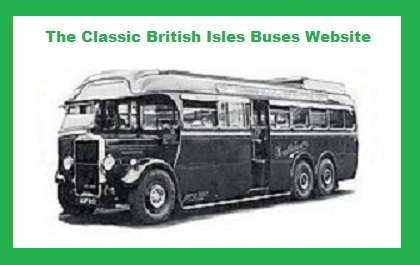

The Classic British Isles Buses Website
Transport in Kyiv, Ukraine 1980s and 1990s (by Dick Gilbert)
Last updated 29 August 2024

Email Events diary Past events list Classified adverts Classic U.K. Buses Classic Irish Buses Classic Manx Buses
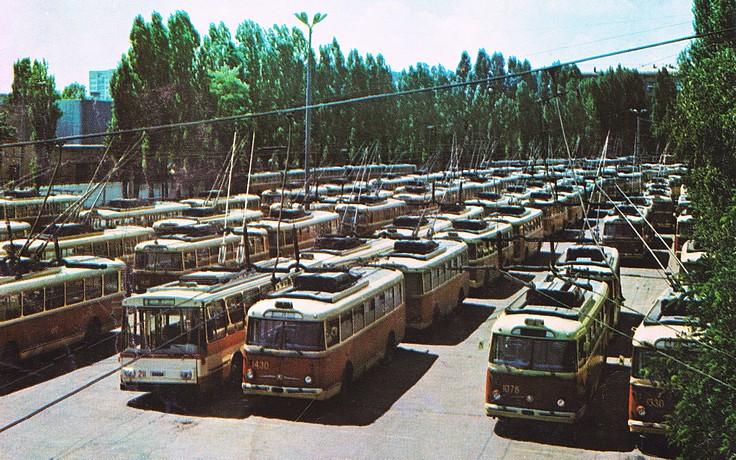
Kyiv's Oktiabrskoye trolleybus depot showing mostly Skoda 9Tr trolleybuses and one 14Tr.
In August 1996 I took an extended business trip to Kyiv, Ukraine. The business was successful, although the price to be paid was some thunderous hangovers, as those who have been entertained by former Soviet aviation people will understand. The local public transportation interested me and I picked up a booklet called Passenger Transport of Kiev (Kiev being the Russian way of spelling the city, and Kyiv the Ukrainian way), much of the contents of which are reproduced on this page - some parts modified for convenience or clearer understanding. It was written in four languages (Ukrainian, English, French and German) and had been published in 1987.
I have included a couple of photos taken by me during my 1996 visit, and some other bits and pieces which will be described as we go along. Note that the names of some buildings and locations in Kyiv have changed since those days, now reflecting local rather than Russian links, and that will be explained too. Here we go:

This view of Khreschatyk Street (Kyiv's Oxford Street), seen from the the roof of a building in Bessarabska Square, was used on the cover of the 1987 brochure. There are several features of interest. At bottom left, parked on the pavement is a Russian Zil-130 truck, and the red tanker (also parked on the pavement) at lower right is probably another one. The five buses parked under the trees would seem to be a coupled-pair of Skoda 9Tr trolleybuses at the front and back, with a single Skoda 14Tr in between them.
"The capital of Soviet Ukraine, ancient and ever young city of Kiev, maintains high rates of socioeconomic progress. Its transport system is kept abreast of the times and is continuously getting perfected. The Metro, trams, trolleybuses and buses are a common sight here and it is hard to imagine that, in the not so distant past, horsecars were slowly moving along the city's streets."
"Initiation of passenger transport in Kiev dates back to 1 June 1892 when the first electric tram in Russia was put into service, its 1.5km track going along the Vladimirsky Descent and Zhdanov Street (present names). By 1913 the total length of tram lines made up to 172km in the city with 224 cars riding on 21 routes."
"For a long time trams were the main public means of transport in Kiev and even today they play an important role in the life of the city. At present their 263.8km long tracks connect large residential areas with the downtown and industrial districts of Kiev. 739 cars convey passengers on 22 routes, with an additional 198 cars on two express tram routes. Millions of people make use of the trams every year."
"The rolling stock of the passenger transport system is kept in 4 tram, 4 trolleybus, 8 bus and 4 taxi depots."
"Power supply of the electric transport is provided by remote-controlled DC traction substations where current is rectified using self-cooled semi-conductor units. Power for the tram and trolleybus traffic is delivered from 72 traction substations with a total power output of 223.3 MW. The contact wire suspension is mainly of load-balanced longitudinal catenary type with updated units (controlled switches and crossings) permitting a constant high running speed."

This is described as the Central District Load-Dispatching Centre, and I assume it controls power distribution across the network. The Dnepr River is visible on the right hand side of the display.
"Proper public and social services are offered at the passenger enterprises of the city. Canteens and cafes are run there, overalls cleaning and repair are provided free of charge. The passenger transport enterprises have at their disposal sanatoriums, sport and tourist centres located on picturesque banks of the Dnepr and Desna rivers. Every year hundreds of workers and employees have their rest in resorts of the Crimea, Caucasus and Carpathians. Their children enjoy staying in splendid pioneer camps Sputnik and Blue Express situated in rich forests of the Kiev region."
"Very popular among the transport workers are houses of culture belonging to transport enterprises and organizations. They boast quite a few libraries and reading-rooms; it is here that performances of the Kiev TTB folk dance, song group and variety shows take place, meetings with famous Kiev actors are arranged and numerous hobby groups get together. Amateur artistic groups of the Kiev Tram and Trolleybus Board are known near and far. They perform for transport workers in other cities and their concerts are often shown in the TV intervision programmes."
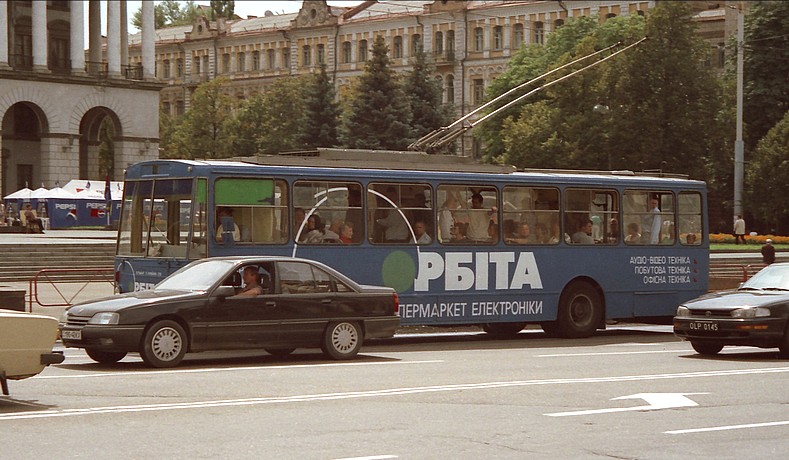
This is a Skoda 14Tr trolleybus wearing an all-over advert for the Orbita Supermarket chain, photographed by me in Maidan Nezalezhnosti, during my visit in August 1996. It wasn't until I set up this picture for the webpage that I noticed the chap behind the bus who appears to be relieving himself into the municipal flowerbed.
"The city's new master plot plan to be realized by the year 2005 envisages further developments of all components in the municipal economy. It involves large scale housing construction, reconstruction of the Kiev passenger railway station, building of an air terminal building and expansion of the Borispol airport capacity. It is planned to build new bus terminals, lay out additional tram and trolleybus routes, and put into service new Metro lines. The existing high-speed tram line will be extended to the Heroes of the Great Patriotic War Square."
"The road network and ground passenger transport system will be further expanded in Kiev. It is envisaged to build circular highways to relieve the city traffic from transit vehicles. As regards the traditional means, the ecologically safest electric transport (trams and trolleybuses) will be intensively developed."
BUSES (In 1986 there were 98 routes and 1,777 buses)

This picture of Skoda 14Tr trolleybus No.190 was taken by me in Khreschatyk Street, Kyiv's upmarket thoroughfare, during my visit in August 1996, some ten years after the brochure was produced.
"Regular bus services commenced in Kiev in the autumn of 1925 on the route from the present Lenin Komsomol Square to Saksagansky Street. At that time only foreign-made buses were used but already in 1929 the local bus fleet received the first homemade vehicles. By the year 1940, 80 buses were riding on the city's routes."
"Now the number of buses comes to about 2,000 with the total length of routes being 814.8km. Thanks to high maneouverability, buses hold first place in the city's passenger traffic."

This is Lenin Komsomol Square (mentioned above and now renamed as European Square) at the north- eastern end of Khreschatyk Street, Kyiv's main thoroughfare. It is dominated by the International Convention Center Ukrainian House, now part of the Kyiv History Museum. Four buses are visible; the two red and white trolleybuses are a Skoda 9Tr coupled-pair. The yellow bus in the foreground might be a school bus or just a yellow local bus, and the white / yellow coach on the right could be an Ikarus 250 tour bus.
TROLLEYBUSES (In 1986 there were 31 routes and 1,089 buses)
"On 5 November 1935 a trolleybus line started functioning here which was the first in Kiev and the second in this country. The trolleybus service was run on the Krasnoarmeyskaya Street between the present Panas Lyubchenko Street and Leo Tolstoy Square. The length of the first route was 3.5km and operating on it were four LK model trolleybuses manufactured at the Kiev Electric Transport Works named after F Dzerzhinsky. In 1940 there were 47 vehicles running on three routes with a total length of 15.4km."
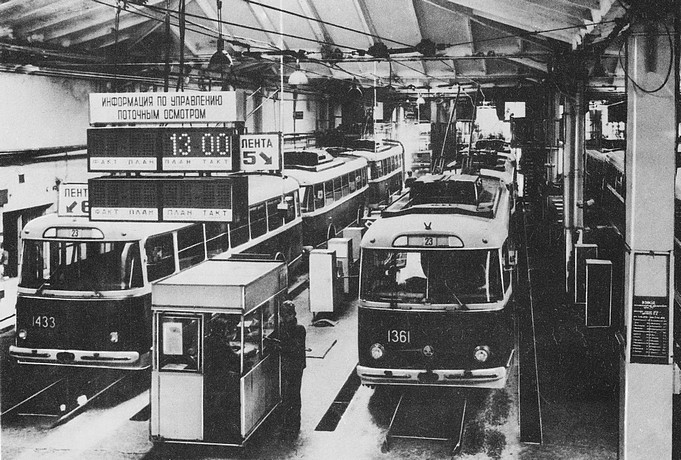
Kyiv's trolleybus maintenance depot with several Skoda 9Tr trolleybuses visible.
"Today the city trolleybus service system runs 31 routes with the total length of 298.9km and 1089 cars. These are comfortable and noiseless vehicles carrying over a million people daily. The local trolleybus lines feature the world's highest rolling stock density (4.2 vehicles per 1km of routes)."
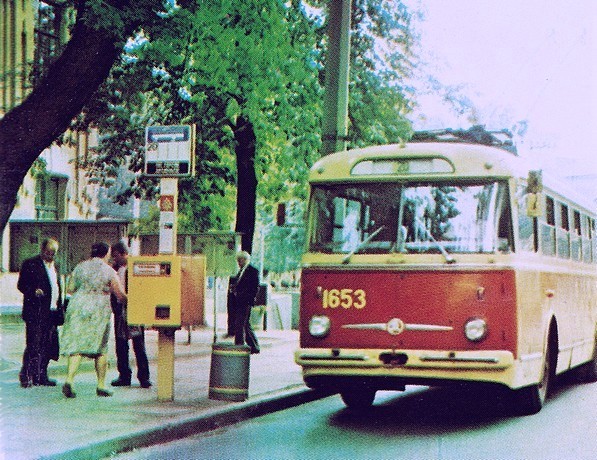
Skoda 9Tr trolleybus No.1653 at a stop with a ticket-selling slot machine.
"Wide use of trolleybuses in the Soviet Union is evidence of great efforts being made in the country to improve the urban ecological situation. Kiev is a world leader as far as the number of trolleybuses and relevant enterprises, the total number of routes and extent of passenger transportation are concerned. All this explains the fact that the foreign public transport specialists take special interest in the experience gained by the Kiev Tram and Trolleybus Board (KTTB)."
METRO (In 1986 there were 2 routes and 385 rolling stock pieces)
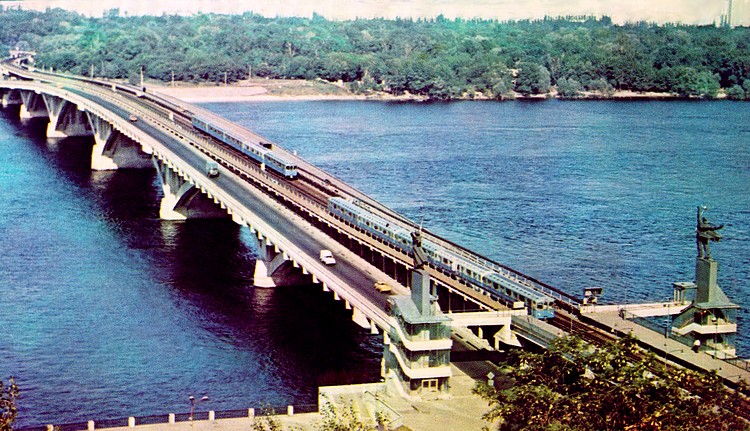
Two five-car Metro trains pass on Kyiv's Metro Bridge over the Dnepr River.
"On 6 November 1960 the first section of the Kiev Metro named after V I Lenin was put into operation. This section of the Svyatoshino-Brovary line extended from the Vokzalnaya to the Dnepr station. In December 1976 the first section of the second Metro line (Kurenevka-Krasnoarmeyskaya) became operational. At present, the third, Syrets-Pechersk line is under construction."
TRAMS (In 1986 there were 24 routes and 937 trams)

Kyiv tram on an urban route.
METRO (In 1986 there were 2 routes and 385 rolling stock pieces)
"The tram fleet track facilities now feature a high technological level of construction and re-construction work, scheduled repair and maintenance operations. Widely used is prefabricated reinforced concrete. Crossings, frogs and rails made of high-manganese steel, cast switches, automatic resistance electric welding of rails find extensive use in upgrading the quality of the tracks."

Kyiv tram tracks being welded at night.
"An adequate industrial basis has been set up for servicing the track facilities. General-purpose and special kinds of equipment are used for track building, reconstruction, overhauls and medium repairs. This equipment includes hopper-batcher and freight tram trains, rail-welding cars, track repairing rail and pneumowheeled mobile shops provided with welding machines, cranes etc. Washing, rail-polishing and snow-removing cars, various vehicle-mounted and tractor-mounted machines as well as special switch-servicing machines are widely used for the maintenance of tracks."
TROLLEYBUS UPDATE 2022
By 2022 the Kyiv trolleybus system consisted of around 600 vehicles (about half of the size of the fleet in use in the period described above) operating on nearly 50 routes. All of the Skoda 9Tr and 14Tr buses had gone, and had been replaced almost entirely with vehicles made in Ukraine (apart from a few MAZ buses built by the Minsk Automobile Plant in Belarus). These consisted of products by the Bogdan Corporation (Cherkasy), LAZ (Lviv Automobile Factory), UMZ (PA Pivdenmash, Dnipro), and some locally-made articulated trolleybuses designated Kyiv-12.03.
Kyiv-12.03 articulated trolleybus number 4030 was destroyed by falling missile fragments in Kyrylivska Street, Kurenivka district of north western Kyiv on 14 March 2022. At least one person died in the incident; according to some reports he was the bus conductor or driver.


Email Events diary Past events list Classified adverts Classic U.K. Buses Classic Irish Buses Classic Manx Buses